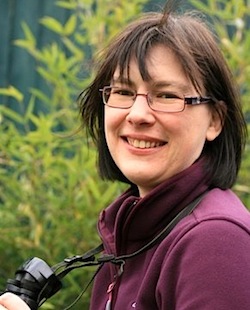Mel Kershaw
Senior Marine Ornithologist
Natural England
Bristol, UK
Involved with the BOU as:
BOU member and former member of the BOU’s Meetings Committee (BOUMC)
BOU member since: 2012
Most likely to be found . . .
. . . out with my camera taking photos, when not stuck in front of a computer screen . . .
Why are you a member of the BOU?
Lots of reasons – access to scientific papers on ornithology published in the BOU journal, IBIS, being able to attend conferences on current ornithological topics, being part of a large community of ornithologists, to keep up-to-date on the latest scientific research in ornithology and to keep in touch with birdy friends and colleagues . . .
What is your role on the BOU committee on which you sit?
I’ve been a member of the BOU Meetings Committee for a couple of years. As the name suggests, the Meeting Committee is responsible for coming up with the annual programme of BOU conferences and meetings. We meet twice a year to discuss the upcoming programme for conferences, and committee members need to ensure that the topics for meetings cover areas of current ornithological interest that will attract a sufficiently large audience from the ornithological community. We also arrange for organising groups to be set up to run the meetings and provide any support they need – one of the Committee members is always in the organising team for any meeting. Our role also includes investigating potential funding opportunities for conferences as it is important that they at least break-even.
What do you enjoy most about your involvement with the BOU?
Attending the meetings and annual conferences. It can be difficult with work pressures to find time to keep up-to-date with current ornithological research and scientific findings, so being able to spend a couple of days at a BOU conference provides a welcome opportunity to hear about the latest research on a particular ornithological topic and to network with the scientists undertaking the research.
When did your interest in ornithology begin?
I was interested in natural history from an early age, but when my parents enrolled me in the Young Ornithologists’ Club for my ninth birthday my taxonomic bias for birds began. I went on a number of YOC birdwatching courses including a fantastic trip to Fair Isle where I got to ring Great Skua and Black Guillemot. I also spent time as a voluntary warden for the RSPB at Leighton Moss, helping with their Bittern research, and at Insh Marshes and Loch Garten, working on ‘Operation Osprey’ which stimulated my interest in conservation and led to my deciding to study zoology at university.
What is your most memorable bird-y experience?
Eventually seeing a Reunion Cuckoo-shrike (known locally as the Tuit-Tuit which is a great name for a bird!) after spending a month searching for them in the montane forests of Reunion Island in the Indian Ocean. At the time there were estimated to be around 120 pairs left on the island in at least two subpopulations. Sadly the species is now thought be down to only 25 pairs, probably restricted to just one of the subpopulations, and the species is now listed as critically endangered.
A close second would be seeing a Diademed Sandpiper-plover in the altiplano in Chile – an amazing bird in an amazing landscape.
What is your favourite outdoor place and why?
Anywhere flat, muddy and estuarine as my favourite group of birds is waders. I also have a particular affinity with Sir Peter Scott’s first Wildfowl and Wetlands Trust centre at Slimbridge on the Severn Estuary, where I worked in the research department for a number of years and also happens to be just up the road from where I live.


